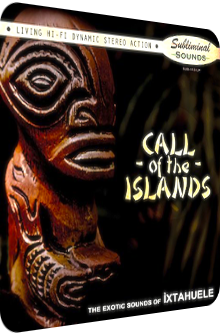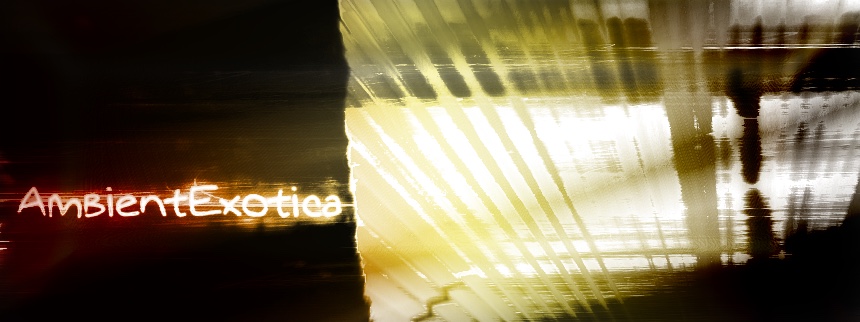
Ìxtahuele
Call Of The Islands
2016
A yearning, a lure… that certain call
As Exotica fans realize whenever they venture into Jazz-based vistas and orchestral paradises: you shouldn't envy the tropical or pacific islanders at all, for these fellows live in paradise 24/7. These poor sobs can therefore never experience the allure, a certain itch, i.e. that special call. Paradise is lost and subsequently found time and again by travelers and tourists all around the globe by means of airwaves and music, and luckily enough, the Swedish Gothenburg-based five-man combo Ìxtahuele continues to follow the call while augmenting it at the same time, thereby making it their very own. Welcome to Call Of The Islands.
After 2012's first online-only teaser in EP form called The Exotic Sounds Of Ìxtahuele, 2013 proved to be the year where Ìxtahuele went into the limelight — or sunburst, if you will — with the majestic full-length debut Pagan Rites that revved up the already prospering tendencies of the inaugural EP. 2014, then, saw the band deliver another three-part EP called Mareld that is, in hindsight, a skillfull finger exercise and foreshadowing device of the thing to come and now finally arrive, Call Of The Islands. Released on Stefan Kéry's Subliminal Sounds label in limited vinyl and plenty o' download versions, the thirteen-track album features the prime cuts from Mareld and merges it with a wondrous zoetrope of Exotica.
The personnel largely remains the same: Mattias Uneback and Wictor Lind are the vibraphonists and percussionists, and as even the flimsiest visitor to exotic la la lands knows, they come up with a panchromatic array of colorful percussion devices to complement the viridian aura of the vibraphones. Dedicated percussionist Johan Hjalmarsson adds another high-plasticity sinew to the parallax peritoneum, while pianist David Löfberg's signature instrument invokes rays of salubrious light by means of sound. The new face in the band is bassist Anders Ljungberg whose strumming of the double bass goes from bubbly over benthic to bone-dry, further boosting the kaleydoscope of moods that encapsulates saffron dunes, vermillion sunsets, glaucous nights and verdured forests.
Diamantine Doldrums
Right from the get-go, Call Of The Islands evokes that insouciant lounge style with the eponymous title track, a style that crystallizes the carefreeness in lieu of making a mundane sell-out of it. Human(e) birdcalls made in Sweden, David Löfberg's softly simmering aquatic piano glissando as well as laid-back maraca-underlined vibraphone veils make this one heck of an ever-important standout track right at the beginning. It feels more like a sunset phase than a matutinal rise-and-shine moment, but that's no bad thing at all, for Exotica comes in many schemes and moods.
With the exotic aorta soothingly pulsating, the easygoing spirit is omnipresent throughout the album, with many related track appearing on the orange-colored horizon. The modern classic Mareld, for instance, transfers well from its EP to the album, bringing in a wider, more Hollywood-like granuloma, what with the playful punctilio on the vibes, the clanging conga clarity and, most importantly so, the mixed choir humming along in paradise. Mareld is one of Ìxtahuele's benchmarks, a curious hybrid of toned-down Exotica and up-the-ante pompousness production-wise. In the end, it is thickly wadded in mellowness, as is the tenth track At Sea whose focus on the alto flute and hammock-friendly tonality present a welcome drowsiness akin to Arthur Lyman's hallmark of sleepy Exotica cuts Hawaiian Sunset (1959), again bringing in the crimson aurorae while the album is far from the finishing line.
Helicoidal Haste
Exotica is not just about the incisive look onto floralcy and tropical gardens; it also covers the wilder sides of life, and it doesn't need Chaino or Sabu to let them come to fruition, for Ìxtahuele have succumbed to medulla-emptying drum escapism — or was that escapades? — time and again, with the infamous Dengue Fever off their very first EP and subsequent album being the spawning point of the craze. On Call Of The Islands, there are prime cuts to be faced and fathomed that mercilessly rev up the dynamic levels of the album, and naturally, there's not much of an escape when hectic times strike and apollonian ayres reign on the island of the mind.
Listeners who already know this album by heart already know that Curitiba Train is secretly mentioned in the above paragraph, and now it is transparently name-dropped here, too. You simply have to adore the schism that is presented there in a playful seriousness: while the piano pericarp is sun-soaked and benignant, the fervent, adiabatic drum monsoon is less amicable, churning and grinding and running on all cylinders, further fueled by bird calls and a cymbal-driven trade wind of brown noise. That's one hell of a train to ride! A tad more toned down but also faux-creepily enigmatic, Temple Of The Snake God gains credence from the clickety-click tambourines but otherwise remains in darker sands; maybe it is the Aztec convexion of the drums, or rather the Oriental staccato melody?
Oriental Orogeny, Latin Leeway
Speaking of the Orient, a term which is de trop in post-millennial times, but applied in eminently good spirit on Exotica records of all decades: Temple Of The Snake God is only one of many archetypal aureoles to bedazzle the listener's cochleae, for Call Of The Islands, while clearly Polynesian through its title alone, doesn't stop and rest at Hawaiian lands and Bora Bora shores. Ìxtahuele instead widen the thematic scope, and decidedly so. Pentatonic tone sequences, timbrical shadiness and moon-lit sceneries that are both lively and dangerous in lieu of just appearing as saccharine and sugar-coated, it is these Oriental tracks that merge puissance with vicissitude.
It is, naturally so, a faux-Oriental approach seen through Hollywood glasses, i.e. the kind of productions a seasoned music historian despises with a passion, but Exotica is about plastic jungles and fakery, so Ìxtahuele plays a fair game, mind you. El Naddaha, as per its title, brings to life a bazaar atmosphere by means of snake charmer flutes that sound more like shawms than the Occidental artifacts they possibly are. Added to the dusty dunes is sprinkling fluidity as realized by the amethystine vibe droplets and argentine cymbal squad. Naturally, the Mareld EP's Rose Of Bukhara must not be missed as a potent runner-up in terms of that spirit, and it is here where the balance between sound, sustain and silence allows the periglacial vibes to shine as brightly as the interim darkness manifests itself in the interstitial holarctic pauses between the soothing drums.
Finally, the Latin way of life is another golden thread whose ubiquity is maintained by the drums, for they are by their very nature all right at home in Latin music. But this delineation aside, there's also the melodic impact that links this album to the Southern parts of America. Ili Pika, for instance, is a bird-infested Cha Cha Cha galore that has subscribed to humid heat through the piano alone and the ever-rasping guiro in the background. Serpentine Roads meanwhile functions as the expectedly twisted road, but even though the piano is woodenly stumbling, a purified grace is maintained through chiastic vibe accompaniments and chirping birds at high noon. Easy and tense, that's quite the attractive blend!
Paradise Maintained
The following statement — foreshadowed by this paragraph's title — may sound like a lukewarm compliment at best and a striking affront at worst, but its ambiguity is used in order to stress the actual sound-based coruscation that is enshrined deep within Call Of The Islands: that paradise is maintained in Ìxtahuele's 2016 LP can be interpreted as a mere maintenance update, and this is certainly to true to some, albeit exotic, extent, but the difference between lackluster maintenance and maintaining paradise in one bold dedicated effort is what makes the music of the Gothenburg-based gentlemen so utterly luring.
Indeed, Call Of The Islands offers more of the same exotic vibes and vibraphones the band is known for, interspersed with congenial percussion segments, pompous drums and enchanting tone sequences of the moony kinds, but to be honest, Exotica fans wouldn't want it any other way. The second full-length work bursts at the seams in the wake of a cinematic pizzazz that never succumbs to the bad kinds of clichés in lieu of catalyzing the rose-tinted paradisiac notion of yesteryear by pouring it into the present… if time would not have come to a halt, that is.
For one thing is certain: each and every of the thirteen productions is delightfully basking in those vintage veils and soothing sinews of '58/'59, with Ìxtahuele gyrating between the faux-oriental aureate trade winds such as Rose Of Bukhara and El Naddaha and the Panavision-esque elasticized wideness of the bone-grinding Curitiba Train and the similarly mellow-dubious diffeomorphism that is Temple Of The Snake God. Whatever strikes your fancy as a Jazz-loving Exotica listener, it is to be found in this auspicious artifact. Call Of The Islands is playful, romantic, scintillating, cheeky, a varieté-matinée portal into the past. If Ìxtahuele is involved, Exotica's omnipresence absorbs you.
Further listening and reading:
- Call Of The Islands is available at Subliminal Sounds as well as all major digital music stores.
- AmbientExotica's reviews about Ìxtahuele: this way.
Exotica Review 477: Ixtahuele – Call Of The Islands (2016). Originally published on Nov. 18, 2016 at AmbientExotica.com.
